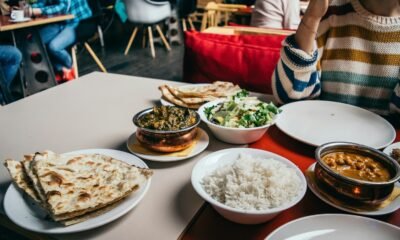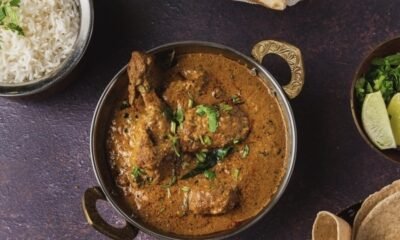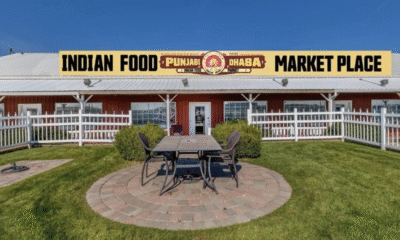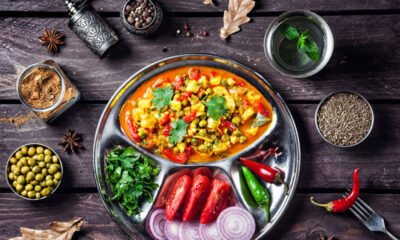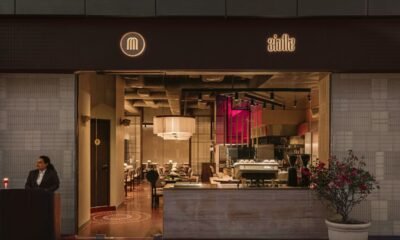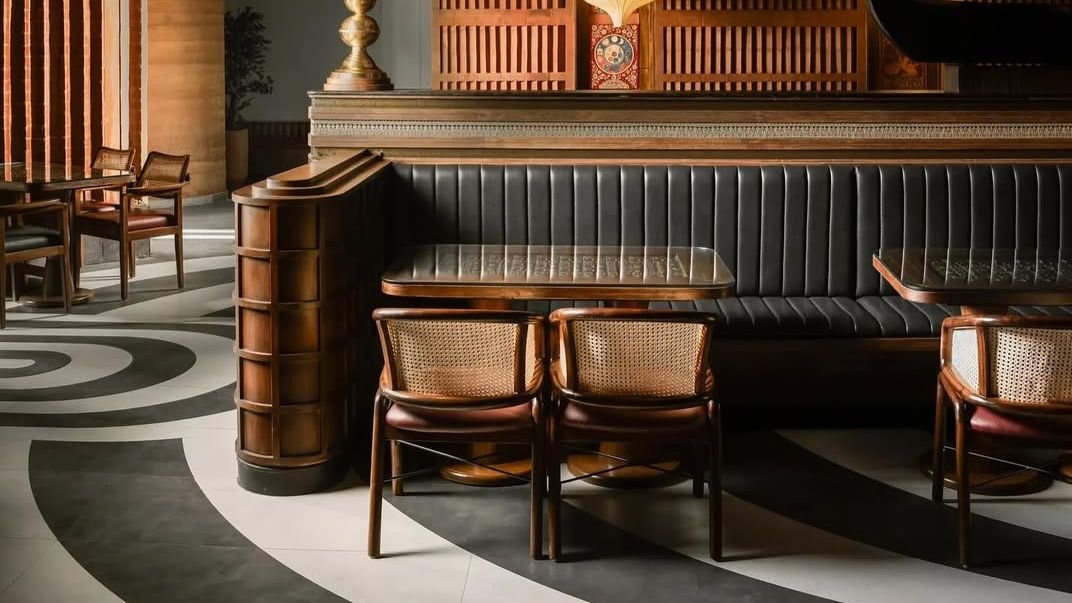Restaurants & Food
The Taste by Vir Sanghvi: Gourmet plates vs communal feasts, why sharing food makes dining joyful
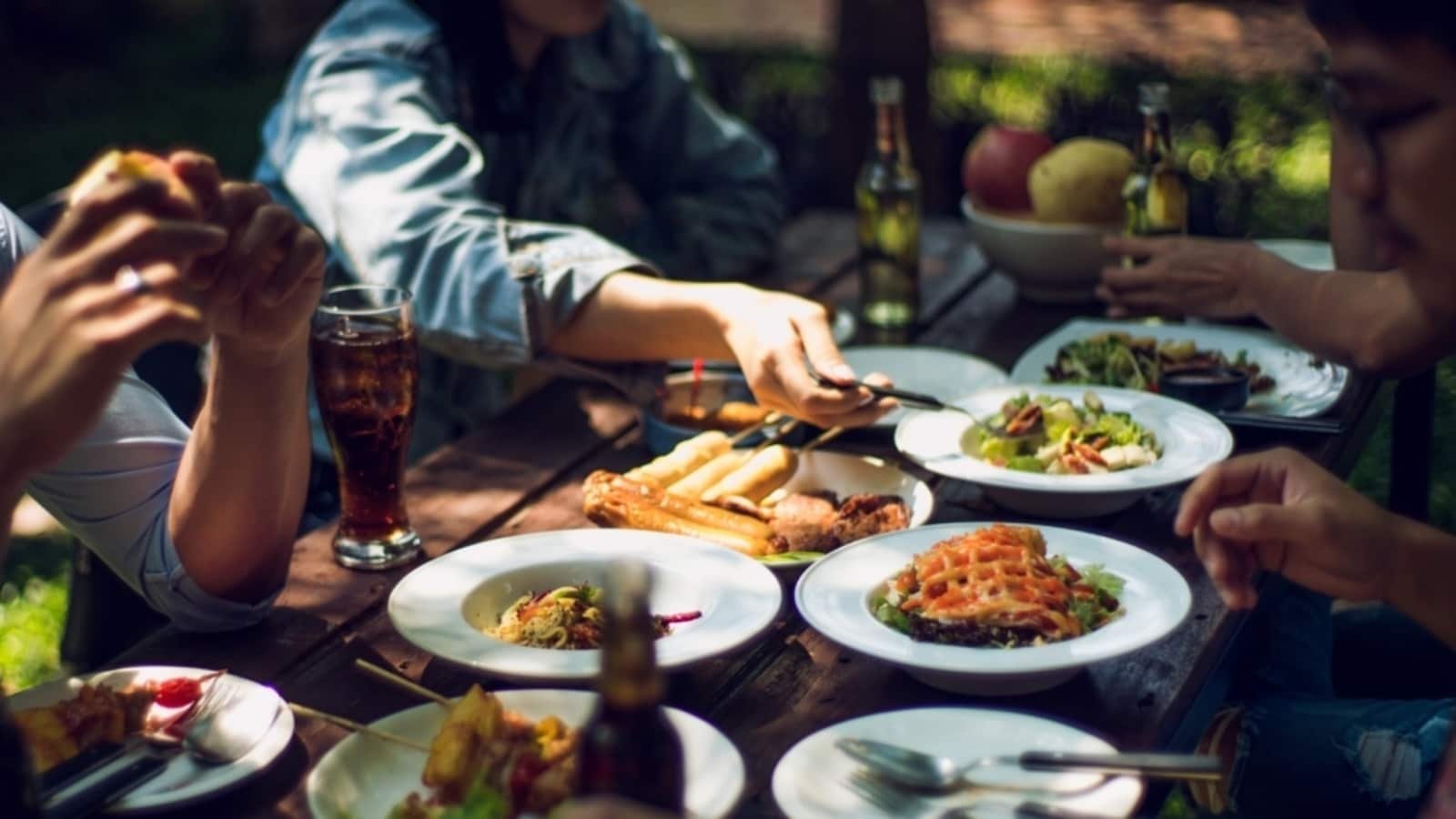
What’s one major difference between eating at home and eating at a fancy European style restaurant?
Easy: At home we share everything. At upmarket restaurants we have to eat fancy food carefully arranged by chefs on pretty plates designed for the single diner. Nothing is meant to be shared.
That, I sometimes think, is also the basic difference between how Indians (perhaps all Asians) and Europeans eat at restaurants.
We share. They keep it to themselves.
It is, I think, the most important factor in deciding which restaurants succeed in India. Think about it. Why do we like going to restaurants that serve butter chicken and biryani? Why do we like places that heap on the hakka noodles so that we can have them with steaming bowls of Chicken Manchurian? Why do we like large pizzas that everyone can share? Platters of Korean fried chicken? Prawn red curry for the whole table?
Indians like sharing. Even when we order dishes that are meant for one person — a hamburger, for instance — we will always share the French fries. All desserts are meant to be eaten communally. Have you ever known anyone to order a single jalebi as an individual dessert?
The West was not very different from us once upon a time even when it came to royal courts and top restaurants. In France, everything used to be served together at the same time for everyone to share and eat.
Service a la Russe or the practice of serving food in courses only started in France in 1810 and did not really catch on till 1860. Even then, food did not necessarily come out from the kitchen in individual plates.
The great dishes of French cooking (say coq au vin or a roast chicken) were meant to be shared. This changed in the 1960s when the nouvelle cuisine movement took over and chefs demanded the right to control exactly what went on the plates. They began all this nonsense about fancy presentation, and just when it seemed like the tide was turning, around a decade ago, Instagram came along and appearance began to count for more than flavour.
The idea of everyone ordering individual dishes did not change at restaurants but it did transmogrify early in this century with the success of El Bulli, the influential Spanish restaurant.
Also Read | The Taste by Vir Sanghvi: Why packed samosas are the ultimate in-flight meal choice for travellers
Till El Bulli came along most great chefs offered a tasting menu featuring slightly smaller versions of their greatest hits over six or seven courses. But there was usually an a la carte menu to choose from as well; and that was the more popular option.
El Bulli made every diner eat exactly the same meal and removed the element of choice. On the other hand, because people were sharing the food, even if it came in individual portions, there was a certain commonality to the experience. But the ‘seven course tasting menu plus a la carte options’ formula at most great restaurants was killed off by the El Bulli effect. Now, portions were small, there was no a la carte and there could be 25 courses.
We think of El Bulli in terms of molecular gastronomy but its real influence may have been in making entire restaurants serve a single menu to everyone, in increasing the number of courses and in serving small plates.
Today almost every great chef serves a single menu at his or her flagship restaurant; from Rene Redzepi to Gaggan Anand. And the old idea of a few courses is dead. At Copenhagen’s much lauded Alchemist, the menu ‘experience’ has 50 courses.
My views on restaurants that give you no choice are mixed. If Rene Redzepi is cooking and you turn down the experience because you want an a la carte menu, then you clearly have no interest in gastronomy. To eat at Gaggan Anand’s restaurant is a privilege. One of my great gastronomic experiences was lunch at Heston Blumenthal’s The Fat Duck.
So, if the chef is super talented then I will eat whatever the chef suggests. It’s not just El Bulli that had this idea. The Japanese concept of Omakase also involves leaving it all up to the chef. And if the chef is a master, who could possibly refuse that opportunity?
The problem is that while I am willing to cede control of my dinner to a genius, I am not willing to make my palate become the hostage of an untalented chef who overestimates his skills and does a tedious tasting menu of underwhelming dishes. And unfortunately, more often than not, it’s the duffer who insists on serving the tasting menu while the geniuses are few and far between.
Besides I have got very tired of fiddly food on pretty plates. I understand the compulsions that chefs face. Two decades ago, Michelin would not recognise Indian chefs cooking abroad unless they served French style plated dishes with no sharing. To the credit of Indian chefs, they managed to do that. But it never seemed quite right.
Now Michelin has accepted that it can’t see the world’s cuisines through the prism of French food. In New York, Semma which serves Indian food as we eat it at home has a star. In London Gymkhana which does the same sort of thing has two Michelin stars.
What I find interesting is how diners in India have mostly refused to bow to the western plated tradition. And how our chefs have managed to straddle both traditions. When I first went to Gaggan he had an a la carte menu. When he switched to a small counter seating restaurant, he went Omakase. But upstairs, above his flagship restaurant, at Maria and Singh, which he also runs, the food comes in sharing portions.
Similarly, Hussain Shazad’s Papa’s is a tasting menu-only counter with seating for 12. But you can eat Hussain’s food the normal way at O Pedro. Himanshu Saini serves a tasting menu at Tresind Studio but if you want more choice you can go to the bigger Tresind. Johnson Ebenezer serves a tasting menu at Bangalore’s Farmlore but when he hosted a lunch for over 100 people for the Ultimate Restaurant Ratings (where Farmlore has the highest possible score of five stars) he managed to turn his cuisine into picnic food. That shows real talent.
Perhaps I am just jaded but I often find myself longing for the joy of shared dishes and hearty food. The best meal I have had in Delhi in weeks was at The China Kitchen where Chef Zhang sent out a huge bowl of fish poached in tingling chilli oil and lots of delicious French beans cooked with spicy minced pork. The following day I went for lunch to Tres and shared hamburgers and an apple tart with a friend. And dinner was at an unpretentious local Italian restaurant called Cala where the plates of hearty pasta and the Naples style pizza epitomised simplicity and fun.
It’s not that I don’t enjoy gourmet food any longer. In Bangalore I was blown away by Manu Chandra’s Lupa where we shared the food and asked for more of his delicious bone marrow. But that was my one (shared, nevertheless) gourmet meal. The rest of the time, my wife and I lived on donne biryani and buttery benne dosas.
When I see other Asian countries evolving in cuisine terms I wonder if they realise that they are embarking on the same journey as us; only they are a decade behind.
I love Thai food but when I see Thai chefs starting to plate what is essentially a sharing cuisine and poncing up the presentation in the pursuit of Michelin stars, I am reminded of how Indian chefs in London had to play the same game. Our chefs worked in an environment that was hostile to Indian food which was treated as a cheap ‘ethnic’ cuisine. They fought that perception and won. The Thais have it easier: They are cooking in their own country. So why play that game now?
Maybe it’s just me. After all these years, I have come to the conclusion that if food is not about joy, then it is about nothing.
Or perhaps it isn’t just me. All over the world food writers are complaining about long tasting menus and the absence of choice and fun at top restaurants.
One sign of the times: The Fat Duck (three Michelin stars for two decades) one of few great restaurants in the world that is dedicated to the idea that food should put a smile on your face and fill your heart with joy now offers more informal options. And instead of the standard tasting menu you can have fun with its topsy turvy menu where you start your meal with dessert.
If you don’t leave a restaurant happy, then what was the point of going?
Restaurants & Food
28 new restaurants in India you should grab a meal at this August – Vogue India
Restaurants & Food
The Taste by Vir Sanghvi: Indian restaurants shine globally with Michelin stars and authentic flavours
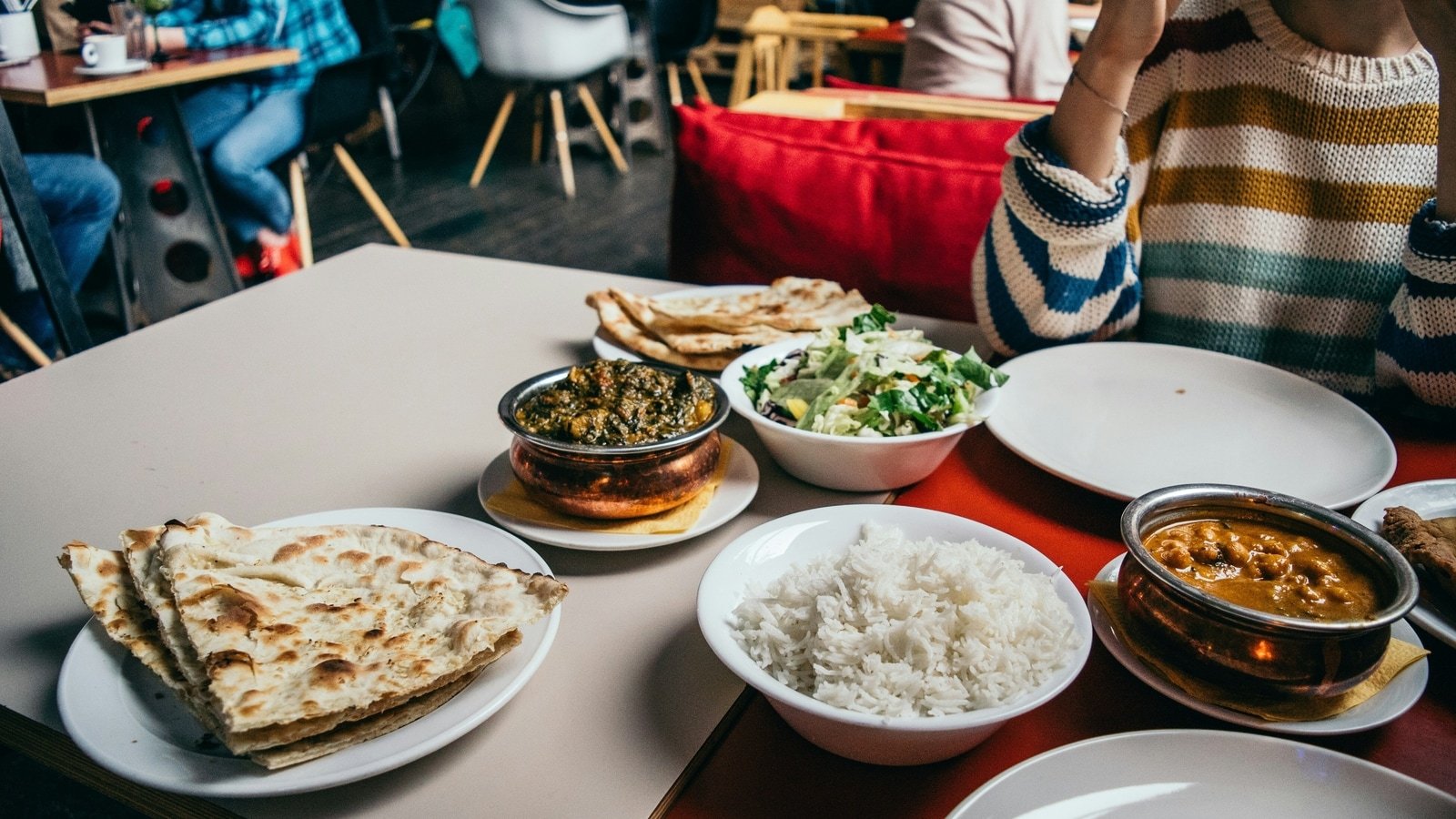
You have probably heard of Semma, the only Indian restaurant in New York to win a Michelin star. And of Gymkhana, the only Indian restaurant with two Michelin stars in London. Of Jamavar, the only Indian restaurant in the world to have won Michelin stars in three different avatars in three different cities: London, Doha and Dubai.
What, you may well ask, do these restaurants have in common?
There are two answers to this question. The first is the obvious one: they are all Indian restaurants run by chefs who have worked or trained in India. Vijaya Kumar of Semma is very proud of cooking the authentic cuisine of Tamil Nadu’s not-so-elevated castes and makes it hot and spicy. (He started out at the Taj Connemara in Chennai.) His boss, and one of the founders of Unapologetic Foods, which owns Semma, Chef Chintan Pandya, says that the group gets its name from its determination to refuse to apologise for the flavours and oil that characterise Indian food. (Chintan is ex-Oberoi.)
In London, one of the first things that Karam Sethi, the chef-founder of Gymkhana, said to me when I called to congratulate him on Gymkhana’s two stars was “it’s real Indian food, not ‘modern’ Indian.” Gymkhana serves the sort of food Indians actually eat, not a poncy, spice-deprived version. Gymkhana’s Executive Chef Sid Ahuja is ex-Oberoi and Sethi himself trained with ITC.
The most recognisable Indian of the top global restaurants is Jamavar. It was founded by Dinesh Nair, whose family used to own Leela Hotels, and is run by his whiz-kid daughter, Samyukta. The London Jamavar is international in clientele but you will nearly always see a top Indian movie star or cricketer there. This may have something to do with the fact that its chef, Surender Mohan, commands after his years working with the Leela group in India.
Samyukta and Surender took Jamavar to Doha where it became just one of two restaurants to win a Michelin star. (The other restaurant with a star is run by Alain Ducasse.) Next, they opened in Dubai and within a few months of opening, they had a star there too.
I met Surender at the Michelin ceremony in Dubai and was pleased to see that he was one of the few chefs not to be intimidated by the occasion and he gave the longest and best speech of the evening. But then I guess he is now used to attending these events in city after city.
Clearly something new and unusual is happening with Indian food abroad even if we don’t fully understand it here in India. There have been, broadly, four phases with Indian food in the West. The first was the ‘ethnic food’ phase when Indian food became the browner equivalent of chop suey and restaurants served mostly made-up Indian dishes at inexpensive prices.
The second was when Indian food went upmarket but was also Frenchified and plated. In the UK, restaurants serving this kind of food were celebrated and some got Michelin stars. In New York, Floyd Cardoz served two kinds of cuisine. At Tabla, he served a nouvelle take on Indian food and got three stars from the New York Times. But downstairs, at the Bread Bar, the food was more basic and less nouvelle. Even so, the general rule was that if you wanted rave reviews and high-profile rich guests, then you moved away from traditional Indian.
The third phase coincided with a global change in food preferences when French food ceased to be as admired as much. As El Bulli and later, Noma, set the trend, this was reflected in Indian food too. Gaggan Anand worked with the Adria brothers of El Bulli and opened a restaurant in Bangkok that served the kind of Indian food nobody had imagined could exist. Also, in Bangkok, Garima Arora opened Gaa which went on to win two Michelin stars. There was a fair amount of cross-fertilisation. Garima had worked with Rene Redzepi at Noma and with Gaggan. Redzepi himself had worked at El Bulli.
Almost simultaneously, Manish Mehrotra, whose resume included no great restaurants, invented his own version of modern Indian cuisine at Delhi’s Indian Accent. Mehrotra’s background was oriental cuisine so he had no interest in Frenchifying his food. Mehrotra and Gaggan ended up being the most influential Indian chefs of this century with their dishes being copied all over the world.
Himanshu Saini, the only Indian chef with a restaurant that has three Michelin stars (Dubai’s Tresind Studio) worked with Manish and is candid about his debt to the master.
But now I think we are into a third phase. People want Indian food without the frills. They want to eat like Indians eat in India. Vikas Khanna, India’s most famous chef, opened Bungalow in New York, serving food that was no different to the food he would serve in India and got three stars from the New York Times, and there’s usually a queue for tables outside his restaurant. At the less expensive end of the market Dhishoom which claims to be inspired by Mumbai’s Irani restaurants is so successful across the UK that it has now set its sights on America.
Of course, no change is absolute. There are still Bangladeshi curry houses calling themselves Indian restaurants. The Frenchified expensive Indian restaurants survive. The Gaggan-style modern Indian is still a rage.
But the trend is clear: Keep it simple and keep it spicy.
Restaurants & Food
Food Picks: Modern Indian with a Western twist at Firangi Superstar
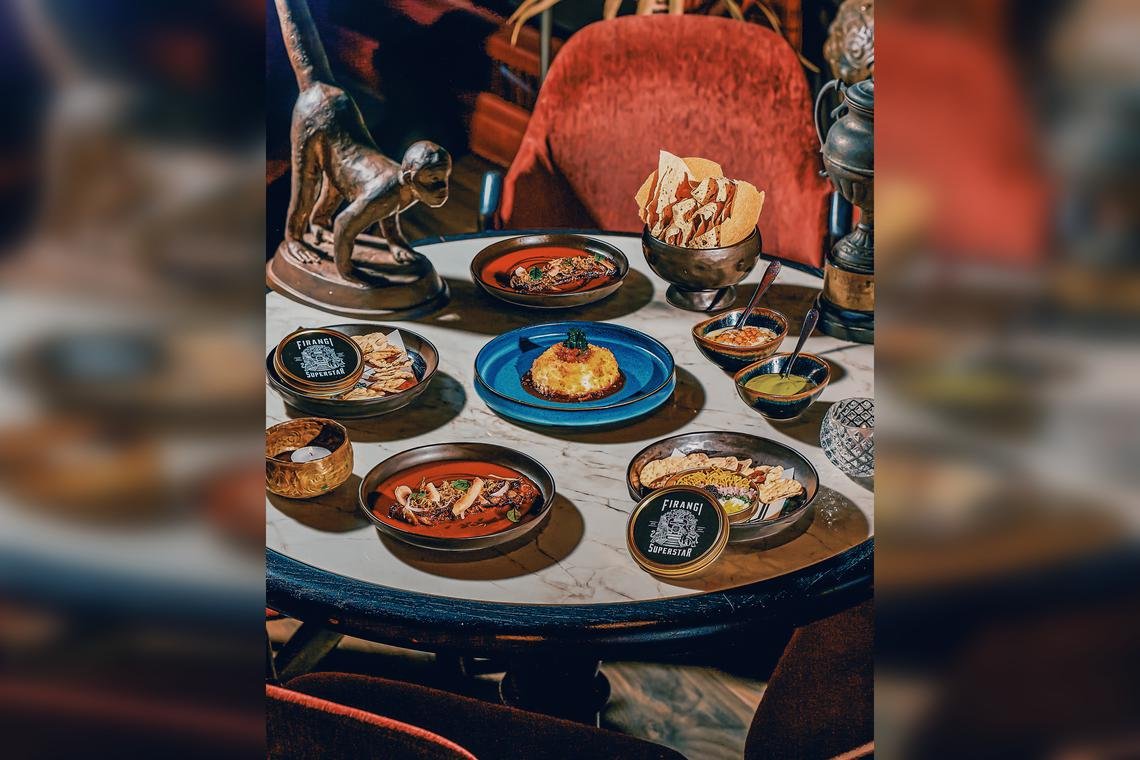
SINGAPORE – Do not be fooled by Firangi Superstar’s plain terracotta exterior. There is nothing minimalist about the experience here.
It overwhelms before the first bite even hits the table, spinning you through rooms crammed with memorabilia. Think American film-maker Wes Anderson on a trip through Delhi, a kind of kitschy fantasyland for colonial nostalgists wrapped in ornate wallpaper and studded with vintage firearms.
Thankfully, this meeting of worlds is far more amicable when confined to the kitchen of this modern Indian restaurant, which opened in 2021.
Firangi Superstar’s decor is as bold as its menu.
PHOTO: FIRANGI SUPERSTAR
Have a seat. Red? Blue? Cushion? Chair? Oh, here comes the menu, recently revamped and folded into a newspaper – with actual clippings, by the way, just in case you were done gawking at the mounted moose heads on the wall and wanted something else to look at.
Open it up. Today’s big story is a list of dishes, both old and new, Indian and international, all with characteristically eyebrow-waggling names.
Some riff off old iterations – This Is Also Not Aloo Gobi ($18++) still holds the traditional curry at arm’s length, even as it borrows its taste. Others squeeze in a winky pun – We’re Goan-Ing To Porto! ($96) beckons to diners with grilled Iberico pork and sorpotel chilli sauce.
Big personalities work only if backed up with big flavours, and Firangi Superstar’s bite is as good as its bark. Starters like Papi’s Jammed Gun ($29++), wagyu beef tartare with caviar, grated egg and gunpowder spice, and Big Baller Peperoner ($28++), its version of paneer Manchurian, with fried burrata and Manchurian chilli sauce, expertly fuse Western ideas with south Asian flair.
The Bengal Bake-Off from Firangi Superstar.
PHOTO: FIRANGI SUPERSTAR
Off to a riotous start, I move on to mains. The Bengal Bake-Off ($108++) is trotted out in show-stopping fashion: a salt-baked seabass emerges from its crust, tender and steaming, and is robed in Kasundi cream.
Back In The Saddle ($21++ for 100g) triumphantly rides in on tandoori-spiced lamb, crowned with confit garlic and chilli leaf. All these dishes also come in vegetarian form, should you so desire.
In the middle of this lip-smacking extravagance, a few humble sides quietly sneak their way onto the table. Turn your attention immediately to the black garlic naan ($14++). Look how pillowy the bread is, breathe in its nutty fragrance. You already know it is going to be a knockout.
End the night with some banoffee fritters ($14++) or Rasmalai “tres leches” ($16++). Recline back on your throne of pillows, cocktail or royal melon lassi ($20++) in hand.
Firangi – Hindi slang for foreigner – or no, one really does feel like a superstar here.
Where: 01-03, 20 Craig Road
MRT: Maxwell/Tanjong Pagar
Open: Noon to 2.30pm, 5.30 to 10pm (Mondays to Saturdays)
Info:
www.firangisuperstar.com
-

 Brand Stories3 weeks ago
Brand Stories3 weeks agoBloom Hotels: A Modern Vision of Hospitality Redefining Travel
-

 Brand Stories2 weeks ago
Brand Stories2 weeks agoCheQin.ai sets a new standard for hotel booking with its AI capabilities: empowering travellers to bargain, choose the best, and book with clarity.
-

 Destinations & Things To Do3 weeks ago
Destinations & Things To Do3 weeks agoUntouched Destinations: Stunning Hidden Gems You Must Visit
-

 Destinations & Things To Do2 weeks ago
Destinations & Things To Do2 weeks agoThis Hidden Beach in India Glows at Night-But Only in One Secret Season
-

 AI in Travel3 weeks ago
AI in Travel3 weeks agoAI Travel Revolution: Must-Have Guide to the Best Experience
-

 Brand Stories1 month ago
Brand Stories1 month agoVoice AI Startup ElevenLabs Plans to Add Hubs Around the World
-

 Brand Stories4 weeks ago
Brand Stories4 weeks agoHow Elon Musk’s rogue Grok chatbot became a cautionary AI tale
-

 Brand Stories2 weeks ago
Brand Stories2 weeks agoContactless Hospitality: Why Remote Management Technology Is Key to Seamless Guest Experiences
-

 Asia Travel Pulse1 month ago
Asia Travel Pulse1 month agoLooking For Adventure In Asia? Here Are 7 Epic Destinations You Need To Experience At Least Once – Zee News
-

 AI in Travel1 month ago
AI in Travel1 month ago‘Will AI take my job?’ A trip to a Beijing fortune-telling bar to see what lies ahead | China

